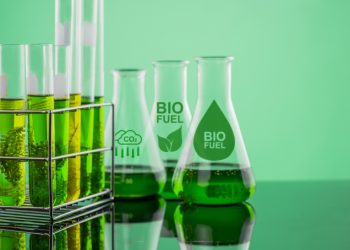Harnessing the University of California’s leadership in sustainability and pledge to become carbon neutral by 2025, Scripps Institution of Oceanography Associate Director Bruce Appelgate had a bright idea: What if Scripps Oceanography at UC San Diego began using 100 percent renewable diesel fuel, or biofuel, to power its research vessels?
Renewable biofuel is nearly carbon-neutral and produces cleaner emissions, thus decreasing greenhouse gas emissions and improving air quality relative to fuels derived from petroleum.
Scripps operates one of the most capable research fleets in the world, which includes three research vessels and one floating research platform. These seagoing vessels, powered by diesel fuel, venture worldwide as the scientists and students on board conduct important research to understand and protect the planet. A noble experiment with biofuel marked the start of a new chapter in sustainability for the Scripps fleet.
“Part of the Scripps mission is to protect the environment, and one of the most significant changes that we could make in our ship operations involved moving toward the use of cleaner, renewable fuels,” said Appelgate, head of Scripps Ship Operations and Marine Technical Support.
“As scientists, we know we need to develop sustainable means of powering our ships to address pollution concerns as well as to mitigate future increases in fossil fuel costs.”
More than 14,400 nautical miles on biofuel alone
Though other varieties of biodiesel require modifications of the ship’s engine in order to be used, the HDRD used to power R/V Robert Gordon Sproul did not require any such adjustments. HDRD biofuel is hydrotreated, meaning all oxygen has been removed, so it’s left with a chemical composition nearly identical to the kind of marine diesel fuel typically used in California.
Over the course of the biofuel experiment, which began in September 2014 and ran through December 2015, R/V Robert Gordon Sproul conducted 39 regular oceanographic research and education missions, spanning 89 operational days at sea, covering more than 14,400 nautical miles, and involving 527 scientists and students. In the process, the vessel used a total of 52,500 gallons of 100-percent renewable diesel. All the while, Russell and her team used instruments installed on board to continuously measure pollutants such as carbon monoxide (CO) and nitrogen oxides (NOx), organic and black carbon aerosols, and engine performance to characterize differences between conventional and renewable fuels.
During two separate five-day research cruises aboard the ship, Scripps postdoctoral scholars Raghu Betha and Derek Price—both with the Climate, Atmospheric Science and Physical Oceanography (CASPO) division at Scripps—collected data for studies that focused on the air quality-related emissions from biofuel in comparison to the emissions from ultra-low sulfur diesel. Two separate tanks on R/V Robert Gordon Sproul held biofuel and diesel, and the researchers could run the ship’s engine from either source, switching back and forth as needed to collect different emission samples.
Betha’s research focused mainly on the direct emissions coming from the ship’s stack (the exhaust piping at the top of the ship) and the criteria of pollutants for air quality. An inlet from the ship stack led directly to an air-sampling trailer, which housed instruments to measure the emitted particles and gases such as CO2 and NOx.
He found that the amount of NOX emissions were about 13 percent lower for biofuel, especially when the ship was running at lower speeds (700 and 1,000 revolutions per minute). The particle emissions, however, were 35 percent higher for biofuel, especially when the engine was running at higher speeds (1,600 revolutions per minute). Black carbon or soot counts were also slightly higher for biofuel.
Particle emissions vs. CO2 emissions
Betha believes that the benefit of having a decrease in CO2 emissions could outweigh the negative of higher particle emissions, since CO2 is a bigger problem for climate. Further, the decrease in NOx was a welcome surprise, since many other types of biofuel have shown increased NOX emissions, said Betha.
Providing biofuel proof of concept
Price found that the emissions from both biofuel and diesel plumes were actually quite similar and mostly composed of hydrocarbon compounds—long carbon chains of alkanes. These large alkane hydrocarbons were then oxidized, changing into more oxygenated compounds due to aging (photochemical reactions) in the atmosphere.
“We were able to show that our existing ship ran as well if not better on biofuel,” said Russell. “The hope is that the price of biofuel will come down as the manufacturing process gets better understood, and as people test it and start adopting it. Now that there’s proof of concept, it should be easy to keep doing it.”
R/V Robert Gordon Sproul is once again running on diesel as its biofuel supply ran out in December 2015. Biofuel has proven itself to be an ideal renewable fuel source for an academic research vessel, but there’s one slight hitch: it costs about 10 percent more than fossil fuel, and ship costs must be kept as low as possible in order to ensure that Scripps students and the next generation of scientists are given shipboard access. This puts biofuel out of reach for the Scripps fleet—at least for the time being—but that could change with the help of private support or other sources of funding.
Source: scripps.ucsd.edu






























































